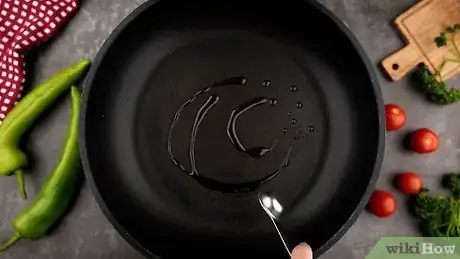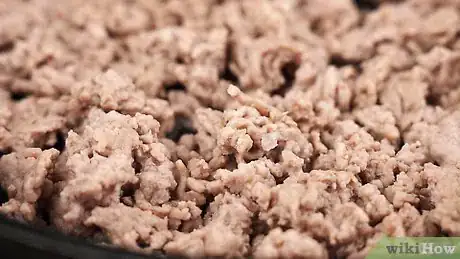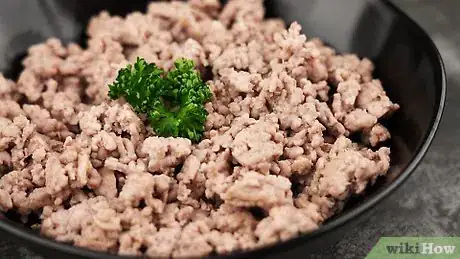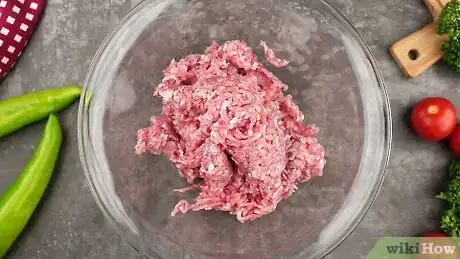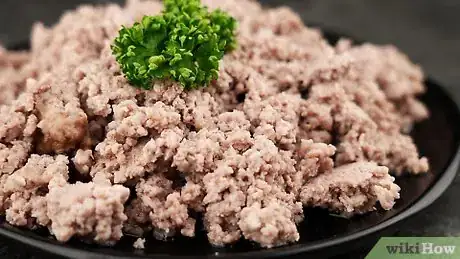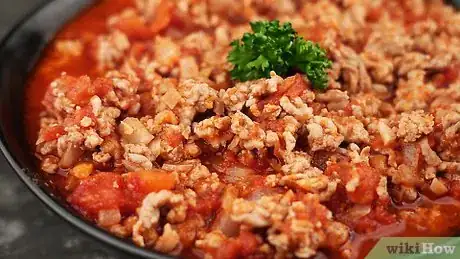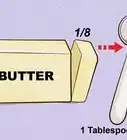wikiHow is a “wiki,” similar to Wikipedia, which means that many of our articles are co-written by multiple authors. To create this article, 9 people, some anonymous, worked to edit and improve it over time.
The wikiHow Culinary Team also followed the article's instructions and verified that they work.
This article has been viewed 285,780 times.
Learn more...
Meat mince—also called ground meat—is a key ingredient in many dishes. Since many recipes require you to cook the mince before adding other ingredients, you can actually prepare the mince separately and use it as needed.
Ingredients
Makes 3 cups (750 ml)
- 1-1/2 lb (675 g) beef mince, turkey mince, or other meat mince
- 1/2 tsp (2.5 ml) table salt (optional)
- 1 tsp (5 ml) vegetable oil (optional)
Makes 2 cups (500 ml)
- 1 lb (450 g) beef mince, turkey mince, or other meat mince
- 1/2 cup (125 ml) water
- 1 to 2 tsp (5 to 10 ml) Worcestershire sauce (optional)
Makes 2 cups (500 ml)
- 1 Tbsp (15 ml) olive oil or vegetable oil
- 1 onion, finely chopped
- 1 garlic clove, minced
- 1 lb (450 g) beef mince, turkey mince, or other meat mince
- 14-oz (400-g) can chopped tomatoes.
- 1/2 tsp (2.5 ml) dried oregano
- 1/2 tsp (2.5 ml) ground black pepper
- 1/2 cup (125 ml) hot water
- 1 tsp (5 ml) beef granules (optional)
Steps
Stovetop Cooking
-
1Heat the oil. Pour 1 tsp (5 ml) of vegetable oil into a large skillet. Set the pan on your stove over medium to medium-high heat.[1]
- This step is technically optional. Most types of mince contain enough fat to cook without the use of separate oils or cooking fats, but coating the skillet with oil can further prevent sticking or scorching. This can be especially helpful if you use a stainless steel pan.
- If you choose to omit the oil, you'll need to watch the mince more closely during the first few minutes of cooking time. More stirring might be required to prevent scorching.
-
2Add the mince. Place the mince in the center of the hot skillet. Use a stiff, heat-resistant spatula to break the meat into large chunks.
- Use fresh or thawed mince instead of frozen.
- If your skillet is not large enough for the full amount, you can cook the mince in batches. Add more oil and reheat the pan as needed before each separate batch.
Advertisement -
3Break the mince further. As the mince browns, continue breaking it apart until it eventually turns into moderately sized crumbles.
- Stir the crumbles periodically as they continue cooking. The stirring should help the mince cook evenly while minimizing the risk of scorching it or drying it out.
- Cooking the mince on a moderately high heat setting should encourage the liquid to evaporate, but if a large puddle of liquid starts to develop, carefully tilt the pan to drain it. Allowing the mince to cook in its juices won't make it unsafe, but it may make the meat taste boiled instead of sauteed.
-
4Sprinkle with salt. Lightly coat the crumbled mince with salt. Gently toss the seasoned mince with your spatula to help distribute the salt.
- This step is also optional, but the addition of salt can help flavor and preserve the meat. If you want to use additional spices when making mince, you should add them during this step.
-
5Check the mince. When the mince seems evenly browned, break open one of the largest crumbles and check the inside. You should not be able to see any pink in the meat.
- You should be able to determine doneness visually, but if you decide to check the mince with a meat thermometer, it should reach an internal temperature of 160 degrees Fahrenheit (70 degrees Celsius).
-
6Use or store as needed. You can use the cooked mince immediately, or you can let it cool and store it for later use.
- If you plan to store the mince, remove the skillet from the heat and allow the meat to cool to room temperature. Transfer it to an airtight container and keep it in your refrigerator for up to one week, or in your freezer for up to three months.
Microwave Cooking
-
1Place the mince in a microwave-safe dish. Place a microwave-safe colander in the center of the dish, then place the mince in the center of the colander.[2]
- You can skip the colander if desired, but using one will allow more of the fat to drain and prevent it from cooking into the meat. A microwavable strainer or trivet set could accomplish the same purpose.
- If using frozen mince, thaw it overnight in your refrigerator before cooking it.
-
2Add the water. Pour the water into the dish and around the dish. Use enough water to fill approximately 1/4 inch (6 mm) of the dish.
- Microwaves can dry out food, but adding water to the dish can keep the air humid and should help prevent the meat from drying out.
-
3Sprinkle the mince with Worcestershire sauce. Evenly drizzle the Worcestershire sauce over the top of the mince, adding just enough to lightly coat the exposed surface of the meat.
- Most forms of mince do not brown on their own in the microwave due to the short cooking time. Worcestershire sauce isn't strictly necessary, but it will add more flavor and color to the finished mince.
- Consider using other brown sauces or seasonings to add color, as well. Options worth trying include dry onion soup mix, teriyaki sauce, barbecue sauce, and steak sauce.
-
4Cover the dish. Loosely cover the entire dish with microwavable plastic wrap. If you use a colander, cover both the colander and the dish beneath it.
- You could cover the dish with a microwavable lid, too, if one is available.
- Covering the dish helps the mince retain more moisture as it cooks. It can also prevent messy splatters.
-
5Cook for 2 minutes. Place the dish in your microwave and cook the mince on full power for 2 minutes.
- Overall cooking time can vary depending on the wattage of your microwave, but 2 minutes should be a safe start time even when using a high-powered microwave.
-
6Stir and continue cooking. Chop up the mince with a spatula or fork. Stir the crumbles, then return the meat to the microwave and continue cooking in 30-second intervals until done.
- The mince will be finished once the meat is steaming hot and brown all the way through. Cut open one of the largest crumbles to verify that no pink remains.
- You shouldn't need to check the mince with a thermometer, but if you choose to do so, the internal temperature should be at least 160 degrees Fahrenheit (70 degrees Celsius).
-
7Use or store as needed. Drain the water and fat from the finished mince, then use the meat immediately or store it for later use.
- When kept in an airtight container, cooked mince remains good for up to one week in the refrigerator or three months in the freezer.
Basic Seasoned Mince
-
1Heat the oil. Pour the oil into a large skillet and place the pan on your stove over medium-high heat.
-
2Cook the onion and garlic. Add the chopped onion and minced garlic to the hot oil. Cook, stirring frequently, for approximately 3 minutes
- Wait until both ingredients become softer and more fragrant. The onion should start looking semi-translucent, and the garlic should deepen in color.
-
3Add the mince. Place the mince in the skillet. Break it apart with a wooden spoon and stir it into the onion and garlic mixture.
- Use fresh or thawed mince. Frozen mince should be defrosted overnight in your refrigerator for best results, but if you're short on time, you can thaw it using the microwave's “defrost” setting.
-
4Cook until browned. Continue cooking the mince, stirring frequently, for approximately 8 to 10 minutes. Thoroughly brown the meat before advancing to the next step.
- All sides of the mince should be brown before you continue, but it's okay if a hint of pink remains inside some of the larger crumbles since the meat will continue cooking for a while longer.
- Consider draining any large puddles of liquid or fat from the skillet before moving onto the next step.
-
5Add the tomatoes and seasonings. Pour the undrained can of tomatoes into the skillet, then evenly sprinkle the contents of the skillet with oregano and black pepper. Stir to combine.
- Other seasonings could be added during this step, as well. Consider using a dried blend of Italian herbs instead of the oregano, or a combination of red pepper and paprika instead of the black pepper and oregano.
-
6Combine the water and beef granules. Stir the beef granules into 1/2 cup (125 ml) of steaming hot water until dissolved. Pour the mixture into the skillet and bring everything to a boil.[3]
- If you would prefer to omit the beef flavor, you do not need to add the beef granules. Simply pour plain water into the skillet during this step. You could also use vegetable stock granules instead of the beef granules.
-
7Simmer for 20 minutes. Reduce the heat to medium-low and allow the mince to simmer for approximately 20 minutes, or until the mince is finished cooking and the flavors have combined.
- Stir the contents of the skillet every 5 minutes or so.
- If the liquid evaporates before the mince finishes, add more water. Pour additional water into the skillet 1/4 cup (60 ml) at a time.
- Do not add any extra water during the last 5 minutes. When ready, the mince should be somewhat dry.
-
8Serve or store as needed. You can use the prepared mince immediately or store it for use in later dishes.
- If you choose to save the mince, remove the skillet from the heat and let the meat cool to room temperature. Place the finished mince in an airtight container and store it in the refrigerator for up to one week, or in the freezer for up to three months.
Community Q&A
-
QuestionHow long does mince take to cook?
 wikiHow Staff EditorThis answer was written by one of our trained team of researchers who validated it for accuracy and comprehensiveness.
wikiHow Staff EditorThis answer was written by one of our trained team of researchers who validated it for accuracy and comprehensiveness.
Staff Answer wikiHow Staff EditorStaff AnswerFor a basic mince, it takes about 15 minutes to prepare the ingredients, and about 30 minutes total to cook.
wikiHow Staff EditorStaff AnswerFor a basic mince, it takes about 15 minutes to prepare the ingredients, and about 30 minutes total to cook. -
QuestionIs it better to boil or fry mince?
 wikiHow Staff EditorThis answer was written by one of our trained team of researchers who validated it for accuracy and comprehensiveness.
wikiHow Staff EditorThis answer was written by one of our trained team of researchers who validated it for accuracy and comprehensiveness.
Staff Answer wikiHow Staff EditorStaff AnswerIt depends on what you’re going for. Boiled mince is less fatty, but it also doesn’t tend to taste as good. Unfortunately, boiling will also remove some of the nutrients. Fried mince has the best flavor and will retain more nutrients, but tends to be higher in fat. You can offset some of this by draining off the fat when you’re done frying it up.
wikiHow Staff EditorStaff AnswerIt depends on what you’re going for. Boiled mince is less fatty, but it also doesn’t tend to taste as good. Unfortunately, boiling will also remove some of the nutrients. Fried mince has the best flavor and will retain more nutrients, but tends to be higher in fat. You can offset some of this by draining off the fat when you’re done frying it up. -
QuestionWhy is my beef mince chewy?
 wikiHow Staff EditorThis answer was written by one of our trained team of researchers who validated it for accuracy and comprehensiveness.
wikiHow Staff EditorThis answer was written by one of our trained team of researchers who validated it for accuracy and comprehensiveness.
Staff Answer wikiHow Staff EditorStaff AnswerThis can happen if you cook your mince too quickly, at too high a temperature. If you let your mince simmer at a low temperature for a long time, it will likely come out softer.
wikiHow Staff EditorStaff AnswerThis can happen if you cook your mince too quickly, at too high a temperature. If you let your mince simmer at a low temperature for a long time, it will likely come out softer.
Things You'll Need
Stovetop Cooking
- Large nonstick skillet
- Spatula
- Airtight container (optional)
Microwave Cooking
- Microwave-safe dish
- Microwave-safe colander (optional)
- Plastic wrap
- Fork or spatula
- Airtight container (optional)
Basic Seasoned Mince
- Large nonstick skillet
- Spatula
- Airtight container (optional)
References
About This Article
To cook mince on a stovetop, first heat 1 teaspoon of vegetable oil over medium-high heat. Once the oil is hot, place the mince in the skillet and break it up with a stiff spatula. As the mince browns, break it down into smaller crumbles with a wooden spoon and season it with 1/2 teaspoon of salt. When you notice the mince is brown, break open one of the crumbles to check if it’s brown all the way through, which means it’s ready. Alternatively, cook the mince in the microwave by placing it in a microwavable container with 1/4 inch of water and some Worcestershire sauce sprinkled on top. Cover the container and cook the mince for 2 minutes before breaking it up with a fork. Then, continue cooking for 30-second intervals until it’s brown all the way through. For tips on how to cook a basic seasoned mince, keep reading!
